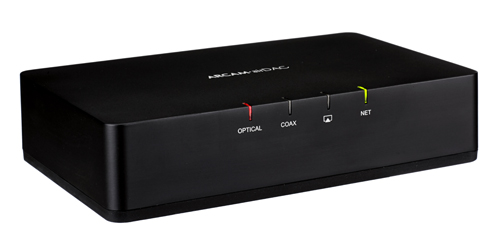What Hi-Fi? Verdict
Good sound quality on a budget for analogue and digital music
Pros
- +
Lively rhythms
- +
Clear, subtle and detailed
- +
Stereo imaging
- +
Connections
- +
Price
Cons
- -
Connections for USB, Bluetooth and 3.5mm would have been useful
Why you can trust What Hi-Fi?
It’s fair to say Arcam has put its airDAC in a rather tricky position.
At £400, it comes in at the same price as the company’s excellent five-star irDAC – but compare the two and, well, the irDAC wins every time in terms of pure audio prowess.
Connections
However, the airDAC’s big selling point is right there in its name – it offers Apple’s AirPlay technology, bringing wireless connectivity to your system in a simple one-box solution.
Set-up is reasonably pain-free, and requires you either to hardwire the airDAC directly via ethernet or by accessing a simple web interface. Step-by-step instructions show how to register it on your network.
For real ease, you can also choose the ‘Access Point Mode’ and hook up to the airDAC by finding it in the list of available wireless networks on your desired output device.
Just make sure the music you play is offline, as you can’t surf the web at the same time.
There’s one seemingly glaring omission on the connections front: a USB input. It seems a little naïve of Arcam to assume that this can be replaced by wireless connectivity, when we’ve all dealt with the frustrations of flaky signal and stop-start music.
Wired connectivity is covered instead by just single coaxial and optical digital ins, with outputs including both analogue and digital outs.
All inputs are capable of playing lossless files of up to 24bit/96kHz, and music streamed in Access Point Mode can hit this quality too.
AirPlay, on the other hand, currently limits its file playback to a maximum of 16bit/48kHz.
This means you are limited in terms of the level of high-resolution music that you can play – something to consider for those with lots of content above 24bit/96kHz.
Performance
For everyone else, the airDAC proves to be a precise performer, offering plenty of fine detail from top to bottom.
Throw a big orchestral track at it, like Harvey Two-Face from the Dark Knight OST, and you’ll hear every single instrument, nicely placed and well integrated, with a level of detail, texture and depth that you just don’t hear if you listen to the source alone.
It could do better with timing and handling of dynamics, but there’s little to complain about with presentation.
It puts weight behind the rumbling bassline of Run the Jewels’ self-titled track, and it prevents the cymbals in Florence and the Machine’s Rabbit Heart (Raise it Up) from sounding harsh.
Choose to stream and you will lose a layer of subtlety and detail, however.
Verdict
The airDAC is good, but falls short of greatness because of a couple of obvious oversights.
If wireless streaming is important to you, this is one to consider. If not, there are better options out there.
MORE: See all our DAC reviews
What Hi-Fi?, founded in 1976, is the world's leading independent guide to buying and owning hi-fi and home entertainment products. Our comprehensive tests help you buy the very best for your money, with our advice sections giving you step-by-step information on how to get even more from your music and movies. Everything is tested by our dedicated team of in-house reviewers in our custom-built test rooms in London, Reading and Bath. Our coveted five-star rating and Awards are recognised all over the world as the ultimate seal of approval, so you can buy with absolute confidence.


